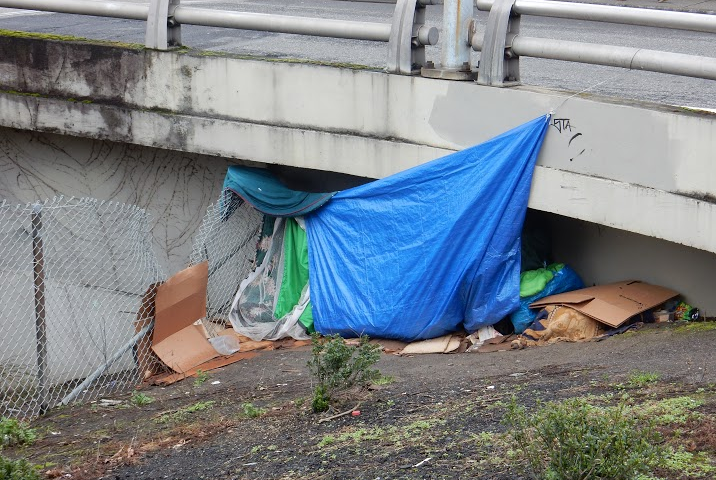Homelessness: A sheltered view
Camps are commonly set up by homeless people across the street from Lincoln.
We recognize that the homeless population around Lincoln is both large and not surprising, given our downtown location. Still, most students are uninformed about homelessness: who it affects, how many it affects, the difficulties of life without a home. Homeless people become stereotypes – lazy, drug-addicted criminals.
But homelessness can affect anybody. In an effort to break through the stereotypes and stigma, we offer a picture of homeless in our own backyard.
Wake-up call
Lincoln’s custodial team is responsible for waking and moving out any homeless people who have found shelter on the school campus the homeless. Each morning before students and staff arrive, custodians walk the grounds and give people 10 minutes to leave.
“They’re generally okay with leaving,” says custodian Jeff Brusse. “There have been a few times when things got verbally abusive” and custodians called police, he says.
In addition, custodians have to keep homeless people away in the evenings.
“Especially at this school, there are a lot of people in the building in the evening, so we don’t want the homeless people here,” Brusse says. Twice recently, Brusse has asked homeless people to leave from inside the school, including a woman who was asking students for their Twitter usernames.
Popular areas for the homeless outside the school are the doorway at the end of the hall near room 152 and at the end of senior hall. Outside of school hours, when homeless are in the rose garden area and not causing a problem, the custodians let them stay.
“There’s no fence, so it’s impossible to keep them off, so we just keep them out of the doorways,” Brusse says.
Young and homeless
Who does Outside In serve?
Homeless youth, ages 16-24. Youth who have experienced a lot of trauma in their homes, about 90 percent report some sort of physical violence, are often fleeing their families. Nationally, about 40 percent of homeless youth identify as queer or LGBTQIA, and when their family finds out or they come out, they are kicked out of their homes. Other reasons for homelessness, especially in youth, include medical issues, mental health issues, drug and alcohol abuse, and mental health issues.
Could homelessness strike anyone?
Mental health issues can happen to anyone. Drug or alcohol addiction can happen in any family. Everybody’s story is different, and lives take many paths, some of which are in our control and some not. Having empathy for others regardless of their scenario is something we can always aspire to.”
Why do homeless people get stereotyped? Some examples might be that they are all criminals, or they all use drugs?
Outside In has been in the community since 1968, and we have around 400 volunteers every year. We have people who think our work is important enough to support financially, even with small donations. All of my work is around bring the community together to support homeless people. Like in politics, there can be many divergent opinions and the comment section on The Oregonian can be a scary place, but if you’re looking for stereotyping, you can find it.”
What challenges do homeless people face sleeping outside?
A number of health issues – being preyed upon, finding proper nutrition and basic health concerns. We provide clean and dry socks, which can be a medical intervention with all the rain in Portland.
Also, finding employment. The stigma of knowing you’re homeless among your peers can be very hard in adolescence. Many of our clients have had a number of transitions in their schooling, so they may be behind. They may be at a disadvantage for transportation to school or work. All of our programs are designed to make sure we’re looking at all the needs someone would have and providing them with the tools to become self sufficient.
What role does mental illness play in homelessness?
I don’t think anyone would be able to lay out the exact role it plays. Living on the streets is not conducive to a healthy mental state. There’s a lot of trauma, it’s an unsafe environment, it can exacerbate a lot of issues.
Do you think that youth face any different issues than older homeless people?
Our goal here is to make sure that homeless youth don’t grow up and join the adult homeless population. We had seen in the past that younger people had a harder time getting employment, and being homeless is one factor in that, but also not having a connection of parents or families or teachers or neighbors or family friends who are willing to stand up and say ‘Hire this kid for the summer.’ We have started a few job training programs and have a network of support to be those advocates for our youth to find employment. Homeless youth, on average are expected to be independent a whole decade before the homed peers. The average of of independence for homed youth is 28.

